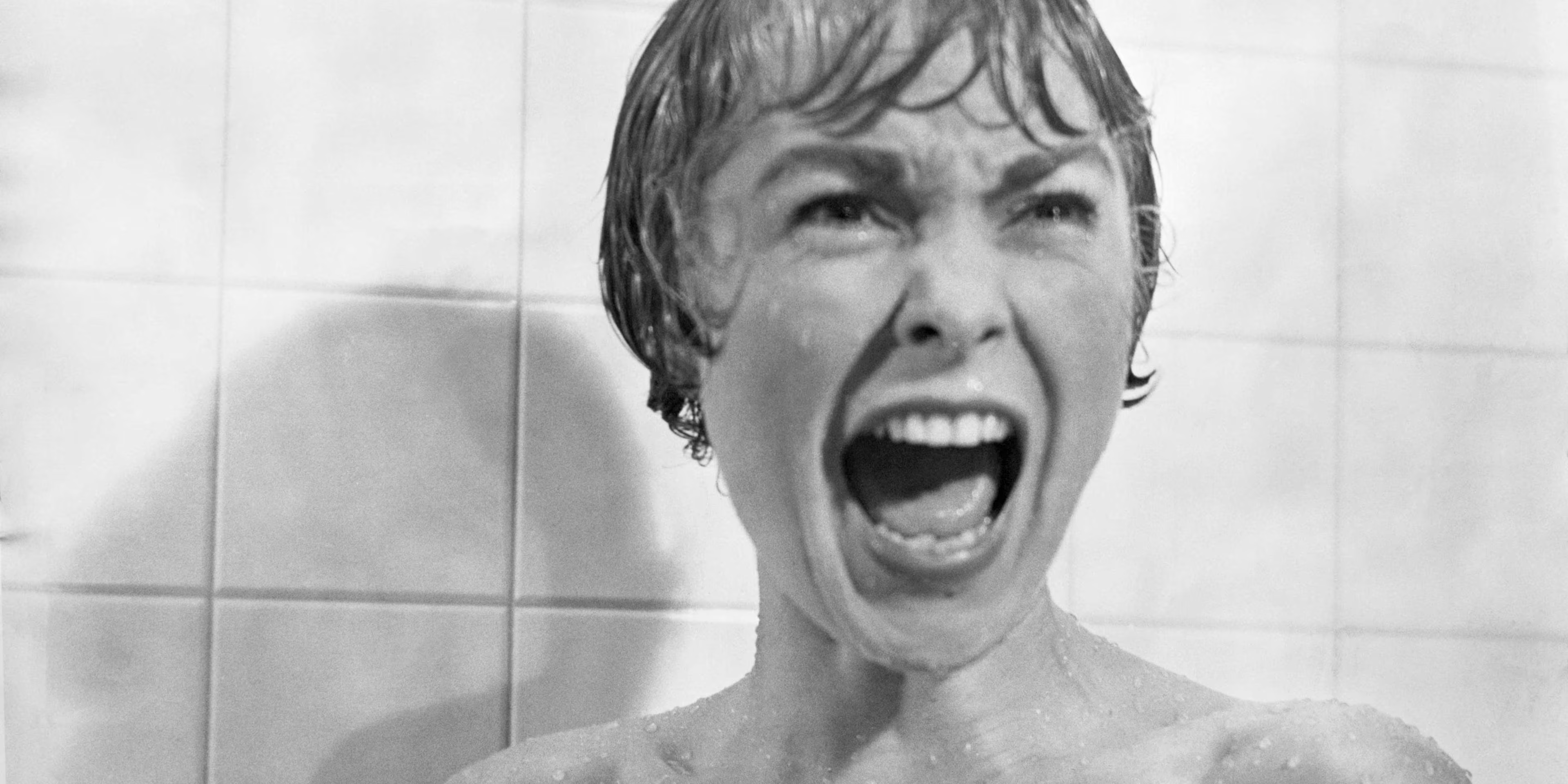By Regina Luz Jordan
Editor In Chief, Hollywoodland News
On June 16, 1960, a secretary named Marion Crane checked into a motel off the highway, took a shower and became one of the most iconic on-screen deaths in Hollywood history. Hitchcock broke all the rules with Psycho. Sixty-five years later, women in horror are still cleaning up the mess. Psycho didn’t just stab her. It slashed through decades of expectations about who gets to survive a story. And spoiler alert: it’s rarely the woman who dares to make her own choices.
Sixty-five years later, Psycho is still hailed as a masterpiece. Critics love to talk about the brilliance of its twist, the shock of the mid-film murder and how Hitchcock “broke the rules.” But here’s what they don’t always say out loud: those new rules, the ones Psycho helped write, made it open season on women who refused to stay in their cinematic place.
Marion didn’t just steal money. She had sex. She told a man she didn’t want to live in shame.
She tried to take control of her life.

And for that, she was punished in the most violent, voyeuristic way possible, through a lens that turned her death into art and her body into a warning.
Psycho didn’t just change horror. It changed the rules of female survival and how women in horror would be written forever. Hollywood has been playing by that bloody rulebook ever since.
The Twist That Changed Everything
(But At What Cost?)
When Psycho premiered in 1960, Hitchcock demanded theaters refuse late entry. Audiences had to be seated from the start or they didn’t get in. The whole damn film hinged on a single devastating twist: the star dies halfway through. I’m sorry if I spoiled that for you but the movie is 65 years old, after all.

Janet Leigh was the big name actress. Marion Crane was the character we were taught to follow, root for and maybe even forgive. She made one bad decision but it was understandable. Relatable even. And then… silence. Knives. Blood down a drain. Boom. Gone and the roles of women in horror were changed when we looked deep into the eye of a dead Marion Crane.

Critics called it revolutionary, bold and groundbreaking. Sure, it definitely was and we’re not here to downplay it’s contribution to a genre so dear to our black hearts.
But let’s not pretend this cinematic gamble didn’t come with a price tag that women in horror have been paying on screen ever since.
Because what happened next was a genre-wide copycat spree. Horror films watched Psycho kill off its “bad girl” and went, Oh, that’s the formula. Suddenly if a woman had sex, broke the rules or refused to play nice, she died. The heroine didn’t die later or quietly.
She was murdered violently and on full display, often with her shirt torn open while the camera lingered like it wanted to take credit for the kill.

Psycho’s twist didn’t just kill Marion. It sent a message: you can be the lead but only until you step out of line and thus the exploitation of women in horror was born..
Sex, Sin & the blueprint built for women in horror
By 1960, the Production Code was barely holding on. For decades it had dictated what movies could and couldn’t show.

That meant no sex, no gore, no queerness, no toilets and no messy human behavior that challenged the image of white, middle class morality. It wasn’t just censorship.
It was obedience disguised as entertainment.
Hitchcock was already tired of playing along. With Psycho, he didn’t just bend the rules, he bulldozed through them. The film opens with an unmarried woman in her bra, fresh from a lunchtime motel hookup, talking about starting a new life. She steals a fat envelope of cash, takes off without a word and does it all without remorse. That alone would’ve been enough to get a film banned just a few years earlier.
But the cracks in the system were getting wider. Films like Some Like It Hot and Anatomy of a Murder had already started challenging the Code. Psycho delivered the final shove. Hitchcock filmed a toilet flush, used quick cuts and sound to imply brutal murder and stripped away the pretense of safety from the screen.
The Code couldn’t stop him so instead, Hollywood followed him.

What Psycho exposed was a new kind of power in filmmaking and not just in regards to women in horror. You didn’t need to show every detail to make an audience squirm. You just needed suggestion, suspense and a woman who had broken the rules. Let’s be very clear here that Marion Crane had broken all of them.

In the wake of Psycho, horror films began leaning hard into moral consequence. The girl who had sex was the first to die. The woman who took charge was framed as a cautionary tale. The camera didn’t just kill her. It lingered and made her body part of the spectacle.
I mean, we address all of these things in the original Scream movie, so I don’t have to tell the masses here.
What started as defiance against the Code became a new system of control. Instead, filmmakers used different tools but the same message. Women who stepped out of line would not make it to the credits.
Hitchcock’s Women Weren’t Just Fictional Victim
The violence in Psycho was not limited to the script. It existed behind the camera, too. Hitchcock demanded complete control over his films and the people in them.
But it was his treatment of actresses crossed a line.

Janet Leigh filmed the infamous shower scene over the course of seven days. She was doused with cold water and pushed through take after take. When filming wrapped, she was physically and emotionally drained. The fear on screen was not just performance. It was exhaustion.

Tippi Hedren had it worse. On the set of The Birds, she was isolated and manipulated. Hitchcock used live birds in scenes that were supposed to be controlled. She was scratched and pecked until her face was bruised and swollen.
It is claimed that he made unwanted advances behind the scenes and retaliated when she refused him. Her career stalled because of it.
This was not artistry. It was exploitation. It was packaged as creative genius and accepted because the results sold tickets. Hitchcock was praised while the women were dismissed or forgotten.
Psycho made Marion Crane iconic but also turned her pain into spectacle. The same happened to the women in horror who portrayed these characters. Their suffering became part of the product. This dynamic set a precedent that Hollywood repeated for decades. Pain was profitable and women were replaceable.
How women in Horror are transforming the Rules
The formula that Psycho helped cement stayed in place for decades. Women who made bold choices were punished. Sex meant death. Survival was reserved for the quiet girl who followed the rules and lived to scream about it. Horror became a genre of consequences with women paying the price.
But the genre has started to shift. Some filmmakers are rewriting the old rulebook and handing the pen to characters who were once doomed from the start. These women are not just victims. They are the story.
In The Babadook, the monster is grief and the mother is allowed to be angry, overwhelmed and deeply human.
Midsommar turns heartbreak and gaslighting into ritual and rebirth. In His House, a refugee mother carries the trauma of displacement without being flattened by it.
These stories make space for women to be complex, flawed, and powerful without being punished for it.


Even slasher films have started to change. X and Pearl gave us women in horror who own their sexuality, chase their dreams and face darkness without begging to be spared. They are not innocent but they are not disposable either. In Abigail, the girl we are told to fear is the one we end up rooting for.
She is the anti-hero. She is violent and vengeful and entirely in control. The film lets her be all of that without apology or punishment.
This shift is not perfect and it is not consistent. The genre still relies on tropes that center pain. Women are still brutalized on screen to create tension or drama. But there is more pushback now. There are more voices demanding better. The audience is paying attention and the stories are finally starting to reflect that.
A Bloody Mirror Still Worth Staring Into

Psycho changed everything. It broke the rules of narrative structure and cracked the surface of the Production Code. It exposed how fear could be sold as entertainment and how violence against women could be rebranded as art. It shaped the future of horror and left women holding the bill.
The film’s legacy is complicated. It is praised for its innovation but rarely interrogated for what it normalized. It did not just kill a character. It carved out a pattern that made female pain a genre. It gave filmmakers permission to punish women in the name of suspense and turned audiences into silent accomplices.
Sixty-five years later, the shadow of Psycho still lingers but the genre it helped define is finally being challenged. The final girl is no longer the only survivor. Sometimes she fights back. Sometimes she wins. Sometimes she burns the whole story down and walks away.
That shift matters. It tells us who we are willing to listen to now. It shows who we are finally ready to watch lead, not just bleed.
If it’s been a while and you want to make your own opinion on women in horror, as of writing this, Psycho is currently available to steam on Netflix.
Lights, Camera, Conversation!
Let’s Keep It Going!
Looking for more of Hollywoodland News‘ coverage of events, editorials or the latest news? Explore our Weekly News for stories on how we continue the fight for representation.


Leave a Reply